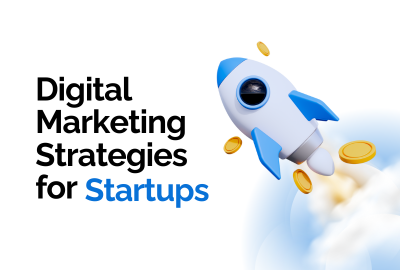
Picture this: You’ve just launched your startup. The product is solid, the team is energetic, and you’re ready to conquer the Indian market. But here’s the thing—crickets. Your amazing solution is sitting there, waiting for customers who don’t even know you exist.
Sound familiar? Don’t worry, you’re not alone. Every successful startup founder has been exactly where you are right now.
Here’s what I’m going to share with you today—three game-changing insights that’ll transform how you approach digital marketing:
In this article, you’ll learn:
- How to choose the right digital marketing channels without wasting money on the wrong ones
- How to create a lean marketing strategy that actually works with your limited budget
- How to measure what matters and pivot fast when something isn’t working
Let’s tackle the core challenge most startup founders face: figuring out where the heck to even start.
Know Your Audience Like Your Best Friend
Before you spend a single rupee on marketing, you need to get crystal clear on who you’re talking to. I’m not talking about generic “millennials in Bangalore” stuff—I mean really knowing your customers.
Create Customer Personas That Actually Matter
Start with three simple questions:
- What keeps your ideal customer awake at 2 AM?
- What would make them jump up and say “Finally, someone gets it!”?
- Where do they hang out online when they’re looking for solutions?
Pro Tip: Don’t guess. Pick up the phone and call 10 potential customers. Yes, it’s scary. Do it anyway.
Low-Budget Market Research That Works
You don’t need expensive research firms. Here’s what actually works:
Social Media Listening
- Join Facebook groups where your audience hangs out
- Monitor Twitter conversations using keywords related to your industry
- Check LinkedIn posts and comments in relevant professional groups
Direct Feedback
- Create simple Google Forms surveys
- Offer small incentives (₹100 Amazon vouchers work wonders)
- Ask existing customers to refer friends for interviews
Competitor Analysis
- Study their social media comments
- Read their Google and app store reviews
- See which content gets the most engagement
Essential Tools for Audience Insights
Free Options:
- Google Analytics (once you get some traffic)
- Facebook Audience Insights
- Twitter Analytics
- LinkedIn Analytics
Budget-Friendly Paid Tools:
- Hotjar (₹2,000/month) for website behavior tracking
- SEMrush (₹8,000/month) for keyword and competitor research
Build Your Digital Home Base
Your website isn’t just a digital brochure—it’s your 24/7 salesperson. And in India’s mobile-first market, it better work perfectly on smartphones.
Website Essentials That Convert
Speed Matters More Than Fancy Design
- Aim for under 3 seconds loading time
- Compress images religiously
- Choose hosting that doesn’t crash during traffic spikes
Mobile-First Design
- Over 70% of Indian internet users are mobile-only
- Test everything on actual smartphones, not just desktop simulators
- Make buttons big enough for thumbs, not mouse clicks
SEO Basics You Can’t Ignore
- Include your target keywords naturally in headlines
- Write meta descriptions that make people want to click
- Create content that answers real questions your customers ask
Choosing the Right Platform
WordPress (Self-hosted)
- Best for content-heavy businesses
- Lots of customization options
- Requires some technical knowledge
Webflow
- Perfect balance of design flexibility and ease of use
- Great for service-based startups
- Higher monthly cost but worth it
Shopify
- If you’re selling products, this is your best bet
- Built-in payment processing for Indian market
- Handles inventory and shipping automatically
Branding Fundamentals for Startups
Keep it simple, but make it memorable:
Visual Identity
- Choose 2-3 colors maximum
- Pick fonts that work on mobile screens
- Create a logo that looks good at tiny sizes
Voice and Tone
- Write like you’re talking to a friend over chai
- Be helpful, not salesy
- Show personality—people buy from people, not corporations
Choose Your Marketing Channels Wisely
Here’s the truth: You can’t be everywhere at once. Trying to master every channel is the fastest way to waste time and money.
The Big Five Marketing Channels
1. Search Engine Optimization (SEO)
- Best for: Long-term organic traffic growth
- Time to results: 3-6 months
- Investment: High time, low money
2. Content Marketing
- Best for: Building trust and authority
- Time to results: 2-4 months
- Investment: Medium time, low money
3. Social Media Marketing
- Best for: Brand awareness and community building
- Time to results: 1-3 months
- Investment: High time, low to medium money
4. Email Marketing
- Best for: Nurturing leads and repeat customers
- Time to results: Immediate for existing lists
- Investment: Low time, low money
5. Paid Advertising (PPC)
- Best for: Fast results and testing
- Time to results: Days to weeks
- Investment: Low time, high money
How to Choose Based on Your Startup Type
B2B SaaS Startups Focus on: SEO + Content Marketing + LinkedIn Why: Long sales cycles need trust-building content
E-commerce/D2C Brands Focus on: Instagram + Google Ads + Email Marketing Why: Visual products need visual platforms
Local Service Businesses Focus on: Google My Business + Facebook + Local SEO Why: People search locally for services
Marketplace/Platform Businesses Focus on: Content Marketing + Community Building + PR Why: Network effects require critical mass
The Power of Focus
Pick TWO channels maximum for your first 6 months. Master them before adding more.
Why This Works:
- You actually get good at something instead of being mediocre at everything
- Your limited time and budget go further
- You can measure what’s working more accurately
Content Marketing Without Breaking the Bank
Content marketing is perfect for cash-strapped startups. It costs more time than money, and the results compound over time.
Build Your Content Strategy in 3 Steps
Step 1: Audit What You Already Know
- What questions do customers ask during sales calls?
- What problems does your product solve?
- What industry insights do you have that others don’t?
Step 2: Create Your Content Pillars Choose 3-4 themes you’ll consistently create content around:
- Educational (How-to guides, tutorials)
- Behind-the-scenes (Founder stories, company culture)
- Industry insights (Trends, predictions, analysis)
- Customer success (Case studies, testimonials)
Step 3: Plan Your Content Calendar
- Start with 1-2 pieces per week
- Batch creation saves time
- Plan 2 weeks ahead minimum
High-Impact Content Types for Startups
Case Studies
- Show real results from real customers
- Include specific numbers and outcomes
- Tell the story: Problem → Solution → Results
How-To Guides
- Answer your customers’ most common questions
- Include screenshots and step-by-step instructions
- Make them bookmark-worthy
Founder Stories
- Share your journey and lessons learned
- Be vulnerable—people connect with real struggles
- Include the “why” behind your startup
Content Repurposing Magic
Create once, publish everywhere:
One Blog Post Becomes:
- 5-7 social media posts
- 1 email newsletter
- 3-4 LinkedIn articles
- 10+ Instagram stories
- 1 podcast episode (if you have one)
One Case Study Becomes:
- Customer testimonial video
- LinkedIn success story post
- Twitter thread
- Instagram carousel
- Email campaign
Master Organic Growth Tactics
Organic growth is your best friend when budgets are tight. It takes longer, but the results last longer too.
SEO Quick Wins for Startups
Local SEO (If Applicable)
- Claim your Google My Business listing
- Get listed in local directories
- Ask happy customers for Google reviews
Keyword Research
- Use Google’s “People also ask” section
- Check what keywords your competitors rank for
- Focus on long-tail keywords (less competition)
Technical SEO Basics
- Install Google Analytics and Search Console
- Create an XML sitemap
- Fix broken links and 404 errors
Social Media Growth Hacks
Instagram Growth
- Use location tags for local discovery
- Engage with similar accounts’ followers
- Share user-generated content
- Post consistently at optimal times (7-9 PM IST works well)
LinkedIn for B2B
- Comment thoughtfully on industry leaders’ posts
- Share valuable insights, not just company updates
- Use LinkedIn polls to boost engagement
- Join and participate in relevant groups
Twitter Strategy
- Share quick tips and insights
- Engage in trending conversations (when relevant)
- Use threads to share longer-form content
- Retweet and add your perspective
Build Your Referral Engine
Customer Referral Program
- Offer incentives for both referrer and referee
- Make it easy to share (one-click sharing)
- Track and optimize your referral process
Partner Collaborations
- Find complementary (not competing) businesses
- Cross-promote to each other’s audiences
- Create joint content or webinars
- Share resources and expertise
Smart Paid Advertising for Startups
When you’re ready to spend money on ads, start small and test everything.
When to Start Using Paid Ads
You’re ready when:
- You have a clear understanding of your target audience
- Your website converts visitors (at least 2-3%)
- You have some budget you can afford to lose while learning
- You can dedicate time to monitor and optimize campaigns
Platform Selection Guide
Google Ads
- Best for: Capturing existing demand
- Budget: Start with ₹10,000-20,000/month
- Focus on: Search ads for high-intent keywords
Facebook & Instagram Ads
- Best for: Building awareness and reaching new audiences
- Budget: Start with ₹8,000-15,000/month
- Focus on: Video content and carousel ads
LinkedIn Ads
- Best for: B2B startups targeting professionals
- Budget: Start with ₹15,000-25,000/month (higher cost per click)
- Focus on: Sponsored content and InMail campaigns
Testing Framework for Small Budgets
The 70-20-10 Rule
- 70% of budget on what’s working
- 20% on improving what’s working
- 10% on testing completely new ideas
Key Metrics to Track
- Cost per click (CPC)
- Click-through rate (CTR)
- Conversion rate
- Customer acquisition cost (CAC)
- Return on ad spend (ROAS)
Build Your Email Marketing Foundation
Email marketing has the highest ROI of any digital marketing channel. For startups, it’s pure gold.
Why Email Marketing is Essential
You Own Your List
- Social media algorithms can change overnight
- Email lists are yours forever
- Direct communication with interested prospects
Cost-Effective
- Most email tools are free for small lists
- Automation handles nurturing while you sleep
- Scales efficiently as you grow
Lead Magnets That Actually Work
For B2B Startups:
- Industry reports and whitepapers
- Free tools or calculators
- Exclusive webinars or workshops
- Checklists and templates
For B2C Startups:
- Discount codes for first purchase
- Free guides or e-books
- Exclusive access to new products
- Contest entries
Email Automation Flows Every Startup Needs
Welcome Series (3-5 emails)
- Email 1: Welcome and set expectations
- Email 2: Share your story and mission
- Email 3: Provide valuable content
- Email 4: Social proof and testimonials
- Email 5: Clear call-to-action
Nurture Sequence
- Send valuable content weekly
- Mix educational and promotional content (80/20 rule)
- Include customer stories and case studies
- Always provide clear next steps
Recommended Email Tools
Free Options:
- Mailchimp (up to 2,000 contacts)
- MailerLite (up to 1,000 contacts)
Paid Options:
- ConvertKit (₹2,000+/month) – great for creators
- HubSpot (₹3,500+/month) – includes CRM
Track What Matters Most
If you’re not measuring, you’re just guessing. But don’t get lost in vanity metrics—focus on what actually drives business growth.
KPIs by Startup Stage
Pre-Revenue Stage
- Website traffic growth
- Email list growth rate
- Social media engagement rate
- Lead generation cost
Early Revenue Stage
- Customer acquisition cost (CAC)
- Monthly recurring revenue (MRR)
- Conversion rate from lead to customer
- Customer lifetime value (CLV)
Growth Stage
- Revenue growth rate
- Customer retention rate
- Viral coefficient
- Market share growth
Essential Tracking Tools
Free Must-Haves
- Google Analytics 4
- Google Search Console
- Facebook Pixel
- LinkedIn Insight Tag
Budget-Friendly Paid Options
- Hotjar (₹2,000/month) for user behavior
- Mixpanel (₹1,500/month) for event tracking
- Ahrefs (₹7,000/month) for SEO tracking
A/B Testing Framework
What to Test:
- Email subject lines
- Landing page headlines
- Call-to-action buttons
- Ad creatives and copy
- Social media post timing
How to Test:
- Change only one element at a time
- Run tests for at least one full week
- Ensure statistical significance
- Document results and learnings
Avoid These Costly Mistakes
Learn from others’ mistakes instead of making them yourself.
Mistake #1: Spreading Yourself Too Thin
What It Looks Like:
- Posting on 6 different social platforms
- Running ads on multiple channels simultaneously
- Creating content without a clear strategy
The Fix:
- Choose 2 marketing channels maximum
- Master them before expanding
- Quality over quantity, always
Mistake #2: Ignoring Brand Building
What It Looks Like:
- Focusing only on direct response marketing
- Constantly pushing sales messages
- No consistent visual identity or voice
The Fix:
- Invest in brand assets early
- Share valuable content regularly
- Build relationships, not just transactions
Mistake #3: Not Tracking Results
What It Looks Like:
- Running campaigns without measuring results
- Making decisions based on gut feeling
- Not knowing which efforts drive the most customers
The Fix:
- Set up tracking before launching campaigns
- Review metrics weekly
- Make data-driven decisions
Your Next Step Forward
Let’s recap the three key takeaways that’ll transform your startup’s digital marketing:
- Choose your channels wisely – Focus on 1-2 channels that align with your audience and business model
- Create a lean strategy – Start with organic growth tactics and scale with paid advertising when ready
- Measure and iterate – Track the right metrics and be ready to pivot when something isn’t working
Here’s what I want you to do right now: Pick ONE marketing channel from this guide and commit to mastering it over the next 30 days.
Want to dive deeper into building a content engine that drives consistent leads? Check out our step-by-step guide to creating content that converts visitors into customers.
Frequently Asked Questions
What’s the best digital marketing strategy for a startup?
There’s no one-size-fits-all answer, but the best strategy is always the one that aligns with your audience and business model. B2B startups often succeed with content marketing and LinkedIn, while B2C brands thrive on Instagram and Google Ads. Start with understanding your customers deeply, then choose channels where they spend time.
How much should I spend on marketing?
For early-stage startups, aim for 15-20% of your revenue on marketing. If you’re pre-revenue, allocate most of your marketing budget to organic strategies (content, SEO, social media) and reserve 20-30% for paid advertising experiments. Start small—₹10,000-20,000 per month for paid ads is plenty to begin testing.
Should I hire help or do it myself?
In the early stages, founders should handle marketing themselves to truly understand their customers and message. Once you’re generating consistent revenue (₹5-10 lakhs per month), consider hiring specialists for specific channels. Freelancers and agencies can be more cost-effective than full-time hires initially.
How long until I see results?
It depends on the channel:
- Paid advertising: 1-4 weeks
- Social media marketing: 1-3 months
- Content marketing: 2-4 months
- SEO: 3-6 months
Set realistic expectations and focus on leading indicators (website traffic, email signups, social engagement) before expecting direct sales results.
What tools do I really need?
Start with free tools and upgrade as you grow: Essential Free Tools: Google Analytics, Google Search Console, social media native analytics First Paid Tools: Email marketing platform (₹1,500/month), social media scheduling tool (₹1,000/month) Growth Stage Tools: CRM system, marketing automation, advanced analytics
What’s the biggest mistake to avoid?
Trying to do everything at once. Most startups fail at marketing because they spread themselves too thin across multiple channels instead of mastering one or two. Pick your battles, focus your efforts, and be patient with the process. Consistent execution beats perfect strategy every time.


